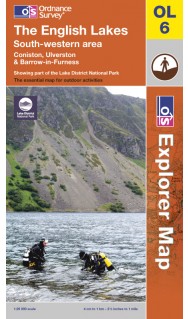Keen fell-walker Tim Bell, explains why there’s plenty to consider before heading up the Lake District Mountains this winter.
Personally, I’ve always preferred the colder months for heading up into the Cumbrian fells. My friends and family still look at me in a baffled way when, on a cold, bleak winters morning, I’m up before the day breaks, preparing a big flask of soup, before heading out the door with the courteous “see you later, I’m off for a walk”. As I close the front door behind me, the inevitable “OK, But Be Careful” advice is offered emphatically from upstairs.

Snow Topped Lake District Fells
And “Careful” I will be. For I know all too well the dangers that those picture-perfect, snow-capped mountains can hide. They might be beautiful and hugely alluring with a crisp, white coat, but head into them without the right preparation and your day might not turn out as planned!
Now don’t get me wrong. It’s not my intention to paint a picture of danger and inevitable doom. By following a few simple pointers, you can achieve the right balance of a safe and rewarding day out in the fells.
1. Equipment
So let’s start with equipment. The type of kit you should ideally be wearing and carrying will vary quite differently from your average summer-time trek. Clothing-wise, it’s all about effective layering, ideally with a thermal/wicking base layer, a seasonably suitable fleece, and an appropriate waterproof & windproof jacket.

Good trekking poles are a handy light weight addition to your kit
Your body should be able to breathe, and the clothing should permit this. Lined winter trekking trousers should ideally be complemented with waterproof over-trousers. Your head & hands (where the vast majority of heat loss occurs) should be covered accordingly.
Never compromise particularly on the quality of your gloves. Lose the feeling in your hands and that’s going to affect your ability to do pretty much everything. A good pair of gloves will last you a lifetime, so make sure they keep out the elements and keep you snug and warm at all times.
Remember, the temperatures on those summits will be significantly lower than what the TV claims.
Factor in the wind-chill, and Cumbria can feel like the inner Arctic Circle. And to keep your head safe should the worst happen, an appropriate helmet is a useful piece of kit.
And finally to the feet. Good winter-ready walking boots, with good tread, and, depending on how serious you want to get, ideally crampon-compatible. Sure, they cost a bit more, but a slip on the ice and snow could well herald serious consequences, so again why compromise?

Crampons are great for grip on ice
If you’re heading into the mountains in the snow, I would always recommend Crampons. Finally, good trekking poles and/or a suitably long-stemmed ice axe.
2. Check the Weather Forecast
Suitably attired, a thorough check of the forecast is a must before heading out. Forget what the TV says, check the accurate mountain forecasts you can find on the internet.

The snowline in the fells, it is a lot cooler up on the top!
They’ll tell you the likely conditions at the various levels of altitude, the risk of snow, blizzards and other meteorological factors which could potentially spoil the day. They’ll give you the regional variances within the mountains too. But, if the weather looks bleak, my advice would be stay at home. Better safe than sorry!
3. Navigation

Ordnance Survey Map of The Lake District: South-western area
The final bit of advice is probably the most important! This applies to any month that you might head out into the fells, but it takes on a more significant role when the terrain and the sky merge into the same disorientating colour.
That’s when it becomes all too easy to veer off course. The ability to read an O.S Map properly with a compass is imperative.
The accuracy of your whereabouts can be further underlined with an appropriate GPS Reader. And don’t be tempted by any “APPS” out there. Mountain Rescue Operations across the UK have increased significantly due to novice walkers heading out into the mountains armed only with their Smartphone for guidance.
These devices were never intended for use in this kind of terrain. For even more peace of mind, there are plenty of companies now offering Winter Navigation courses. I would highly recommend these for the skills and confidence they give you. And of course, before setting off choose a route suitable to the weather, your skills and physical ability. Walking in winter is physically way more demanding in the winter months.
Remember, this post is by no means a definitive list or tips and safety advice. Walling in winter can be dangerous. So, if like me, you’re thinking of heading out into the fells this winter, be prepared and above all, be safe.
Written by: Tim Bell, General Manger of Lancaster House
